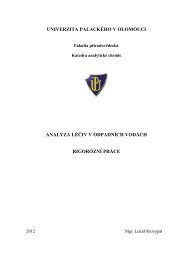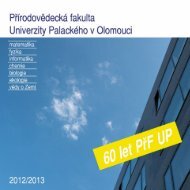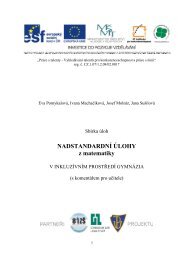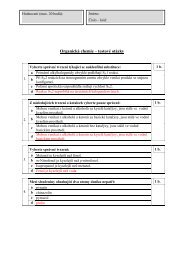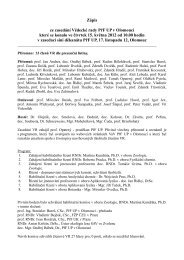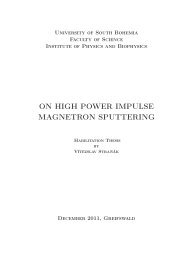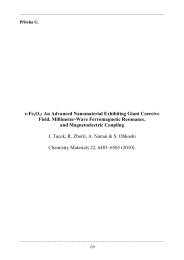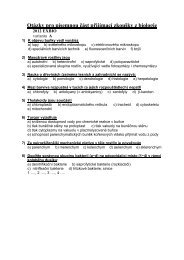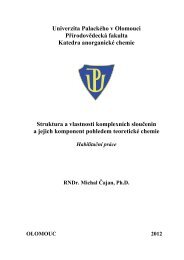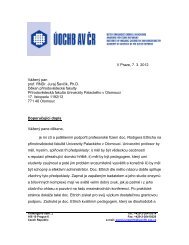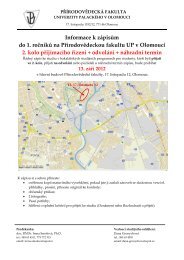A comparative structural analysis of direct and indirect shoot ...
A comparative structural analysis of direct and indirect shoot ...
A comparative structural analysis of direct and indirect shoot ...
You also want an ePaper? Increase the reach of your titles
YUMPU automatically turns print PDFs into web optimized ePapers that Google loves.
Shoot regeneration in opium poppy<br />
285<br />
Figure 3. In<strong>direct</strong> <strong>shoot</strong> regeneration. 1. Cell determination.<br />
a. Production <strong>of</strong> meristemoids within the callus tissue. Bar =<br />
50 µm. b. Tight cell adhesion <strong>and</strong> meristematic nature <strong>of</strong><br />
the meristemoid cells. Note the cytological differences<br />
(cytoplasmic density, thickness <strong>and</strong> stainability <strong>of</strong> the cell<br />
wall) between peripheral dividing cells <strong>and</strong> cells accumulating<br />
starch granules. Bar = 50 µm. c. Numerous globular<br />
meristemoids appearing mostly on the callus surface. Cell<br />
arrangement in the meristemoids was r<strong>and</strong>om, but they had<br />
compact, non-friable nature. Bar = 50 µm. d, e, f, g, – Ultrastructure<br />
<strong>of</strong> the central meristemoid cells. d. Transparent<br />
cytoplasm <strong>and</strong> large deposits <strong>of</strong> starch in the central cells.<br />
Bar = 10 µm. e. Insertion <strong>of</strong> vesicular <strong>and</strong> matrix material<br />
into the cell wall <strong>of</strong> central meristemoid cells by exocytosis.<br />
L-lipid droplet. Bar = 2 µm. f. Lipid droplets which fill up the<br />
cells in the transition layer between centre <strong>and</strong> periphery <strong>of</strong><br />
the meristemoid. Bar = 10 µm. g. Cell wall ingrowths (asterisk)<br />
in the central meristemoid cell. Note the presence <strong>of</strong><br />
numerous mitochondria. Bar = 2 µm.<br />
eral meristemoid cells were more rounded <strong>and</strong> cells <strong>of</strong> <strong>shoot</strong><br />
apical meristem were more oblong. However, unlike these differences<br />
in cell size <strong>and</strong> shape, in both meristemoid periphery<br />
(Fig. 7a) <strong>and</strong> <strong>shoot</strong> apical meristem (Fig. 7b), cell growth<br />
was closely related to the similar negative correlation<br />
between cell size <strong>and</strong> cell shape. Increase in the mean <strong>of</strong> cell<br />
size was found to be followed by general decrease in the<br />
mean <strong>of</strong> form factor (Figs. 7 a, b). In conclusion, most <strong>of</strong> the<br />
cytological <strong>and</strong> morphometrical observations indicate that<br />
only peripheral meristemoid cells can be identified as determined<br />
cells during in<strong>direct</strong> <strong>shoot</strong> organogenesis.<br />
Discussion<br />
This study deals with cytological characterisation <strong>of</strong> de novo<br />
<strong>shoot</strong> regeneration <strong>of</strong> P. somniferum L. in vitro, focusing from<br />
the morphogenetical point <strong>of</strong> view on the differences between<br />
<strong>direct</strong> <strong>and</strong> in<strong>direct</strong> <strong>shoot</strong> primordia formation. Shoot organogenesis<br />
is a suitable experimental system for use in discerning<br />
patterns <strong>of</strong> cell division <strong>and</strong> expansion in order to<br />
compare <strong>direct</strong> <strong>and</strong> in<strong>direct</strong> caulogenetic determination.<br />
Three developmental steps have been identified in distinct<br />
<strong>shoot</strong>-forming cultures: (I) initiation <strong>of</strong> meristematic activity in<br />
callus or explant as an expression <strong>of</strong> the morphogenetic<br />
competence; (II) cell determination during formation <strong>of</strong> meristematic<br />
nodules; <strong>and</strong> (III) differentiation <strong>of</strong> adventitious <strong>shoot</strong><br />
buds (Von Arnold <strong>and</strong> Eriksson 1985, Bobák et al. 1989,<br />
Sharma <strong>and</strong> Bhojwani 1990, Colby et al. 1991, Lakshmanan<br />
et al. 1997). In contrast to well established models <strong>of</strong> <strong>shoot</strong><br />
regeneration, the <strong>structural</strong> details <strong>of</strong> <strong>shoot</strong> primordia initiation<br />
<strong>and</strong> development are missing in studies <strong>of</strong> organogenic<br />
poppy callus culture. In addition, <strong>direct</strong> <strong>shoot</strong> organogenesis<br />
<strong>of</strong> opium poppy has not been published before now. The<br />
question here was what aspects <strong>of</strong> cell division, cell expansion,<br />
<strong>and</strong> cell differentiation are related to cellular origin <strong>of</strong><br />
<strong>shoot</strong> primordia during either <strong>direct</strong> or in<strong>direct</strong> <strong>shoot</strong> regeneration.




